La Trobe University Common Law Assignment: Contract Law Analysis
VerifiedAdded on 2023/06/08
|9
|2047
|270
Homework Assignment
AI Summary
This document provides solutions to a common law assignment focused on contract law principles. It addresses several scenarios, including the validity of exclusion clauses, breach of contract, and the determination of contractual terms. The first solution examines the enforceability of an exclusion clause in a hiring agreement. The second solution analyzes a breach of contract scenario involving a painter and a store owner. The third solution explores whether a pre-contractual statement constitutes a term of the contract. The final solution considers the presence of an implied term in a laptop hire agreement. Each solution identifies the issue, relevant law, applies the law to the facts, and provides a conclusion, offering a comprehensive analysis of the legal principles involved and their application to the given scenarios. The assignment emphasizes the application of legal principles and case law to specific factual situations to determine the legal outcomes.
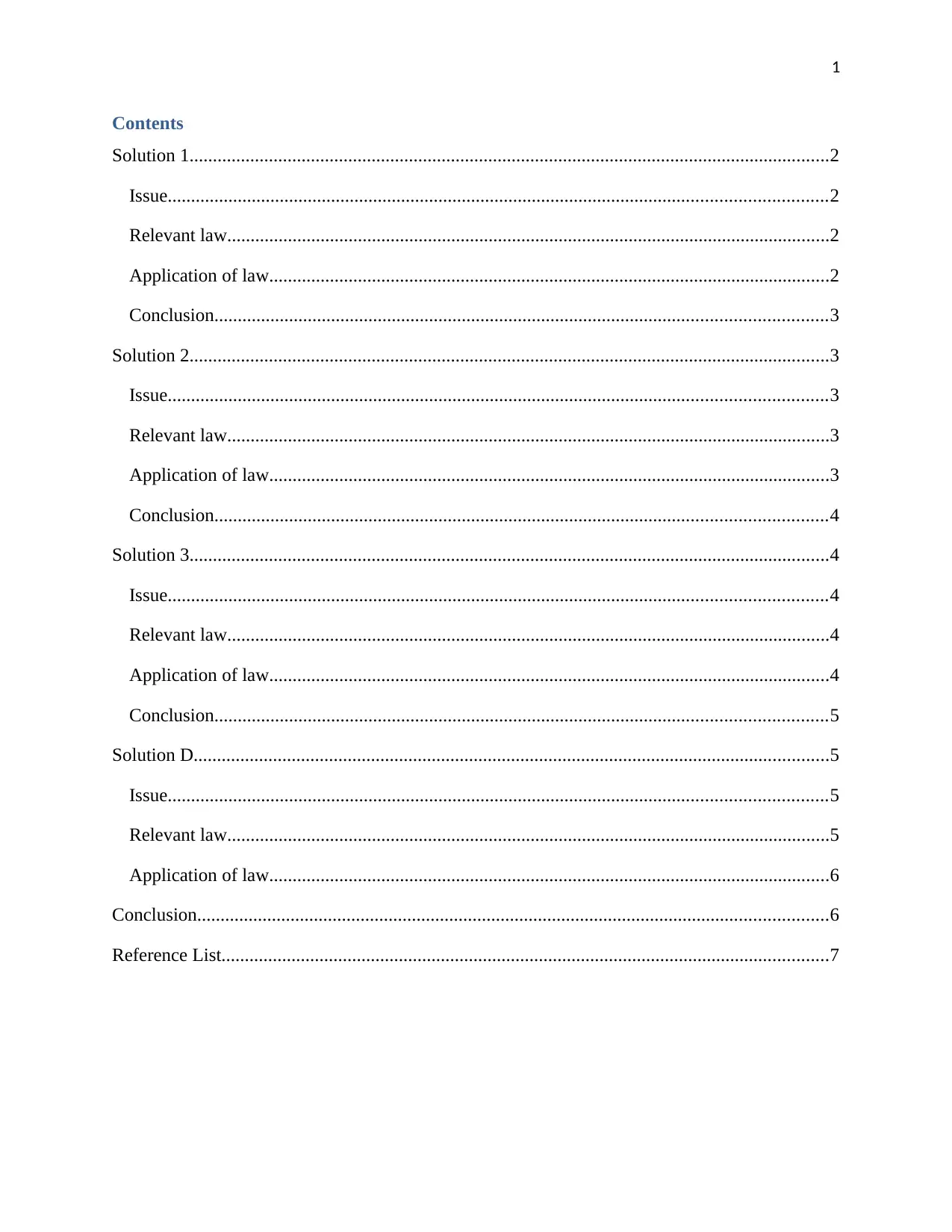
1
Contents
Solution 1.........................................................................................................................................2
Issue.............................................................................................................................................2
Relevant law.................................................................................................................................2
Application of law........................................................................................................................2
Conclusion...................................................................................................................................3
Solution 2.........................................................................................................................................3
Issue.............................................................................................................................................3
Relevant law.................................................................................................................................3
Application of law........................................................................................................................3
Conclusion...................................................................................................................................4
Solution 3.........................................................................................................................................4
Issue.............................................................................................................................................4
Relevant law.................................................................................................................................4
Application of law........................................................................................................................4
Conclusion...................................................................................................................................5
Solution D........................................................................................................................................5
Issue.............................................................................................................................................5
Relevant law.................................................................................................................................5
Application of law........................................................................................................................6
Conclusion.......................................................................................................................................6
Reference List..................................................................................................................................7
Contents
Solution 1.........................................................................................................................................2
Issue.............................................................................................................................................2
Relevant law.................................................................................................................................2
Application of law........................................................................................................................2
Conclusion...................................................................................................................................3
Solution 2.........................................................................................................................................3
Issue.............................................................................................................................................3
Relevant law.................................................................................................................................3
Application of law........................................................................................................................3
Conclusion...................................................................................................................................4
Solution 3.........................................................................................................................................4
Issue.............................................................................................................................................4
Relevant law.................................................................................................................................4
Application of law........................................................................................................................4
Conclusion...................................................................................................................................5
Solution D........................................................................................................................................5
Issue.............................................................................................................................................5
Relevant law.................................................................................................................................5
Application of law........................................................................................................................6
Conclusion.......................................................................................................................................6
Reference List..................................................................................................................................7
Paraphrase This Document
Need a fresh take? Get an instant paraphrase of this document with our AI Paraphraser
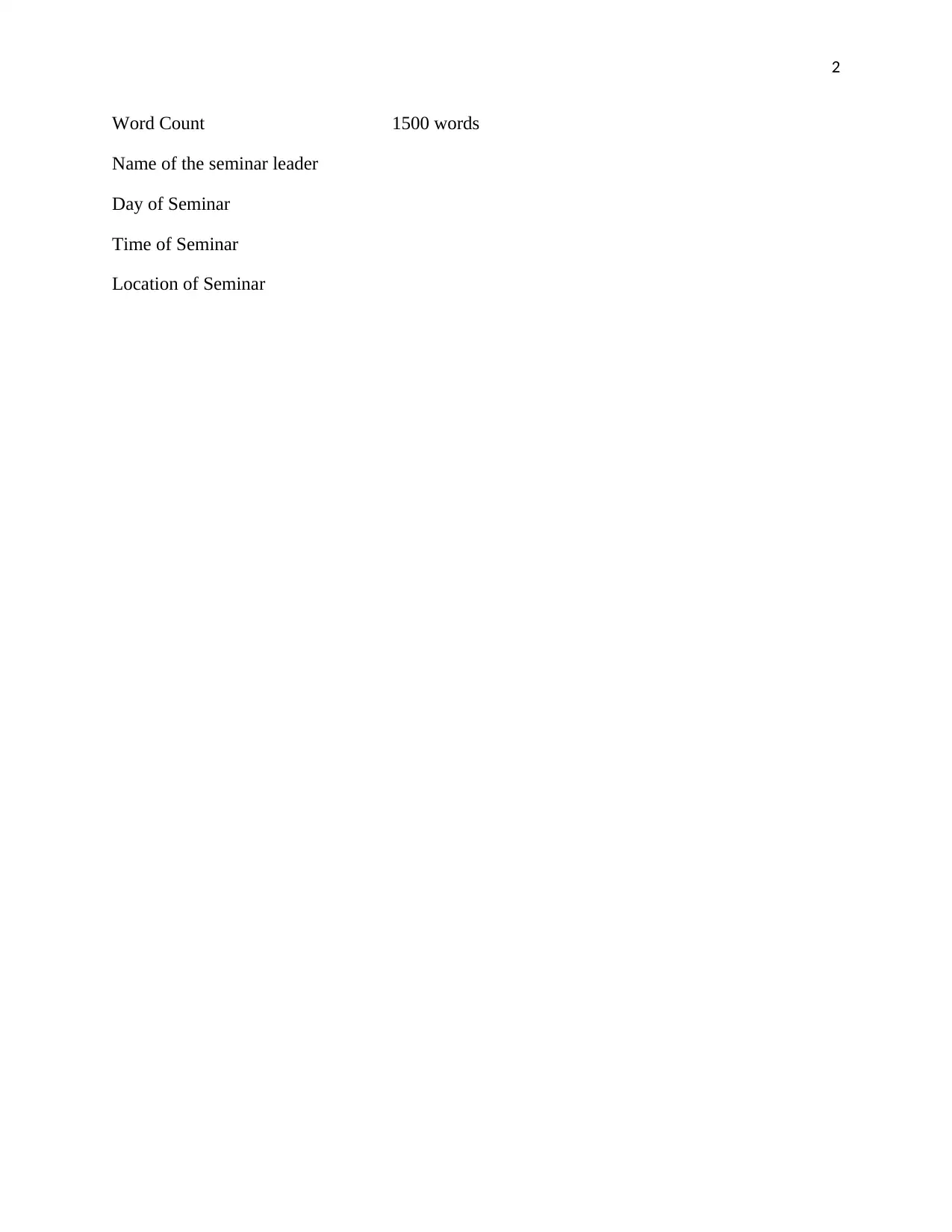
2
Word Count 1500 words
Name of the seminar leader
Day of Seminar
Time of Seminar
Location of Seminar
Word Count 1500 words
Name of the seminar leader
Day of Seminar
Time of Seminar
Location of Seminar
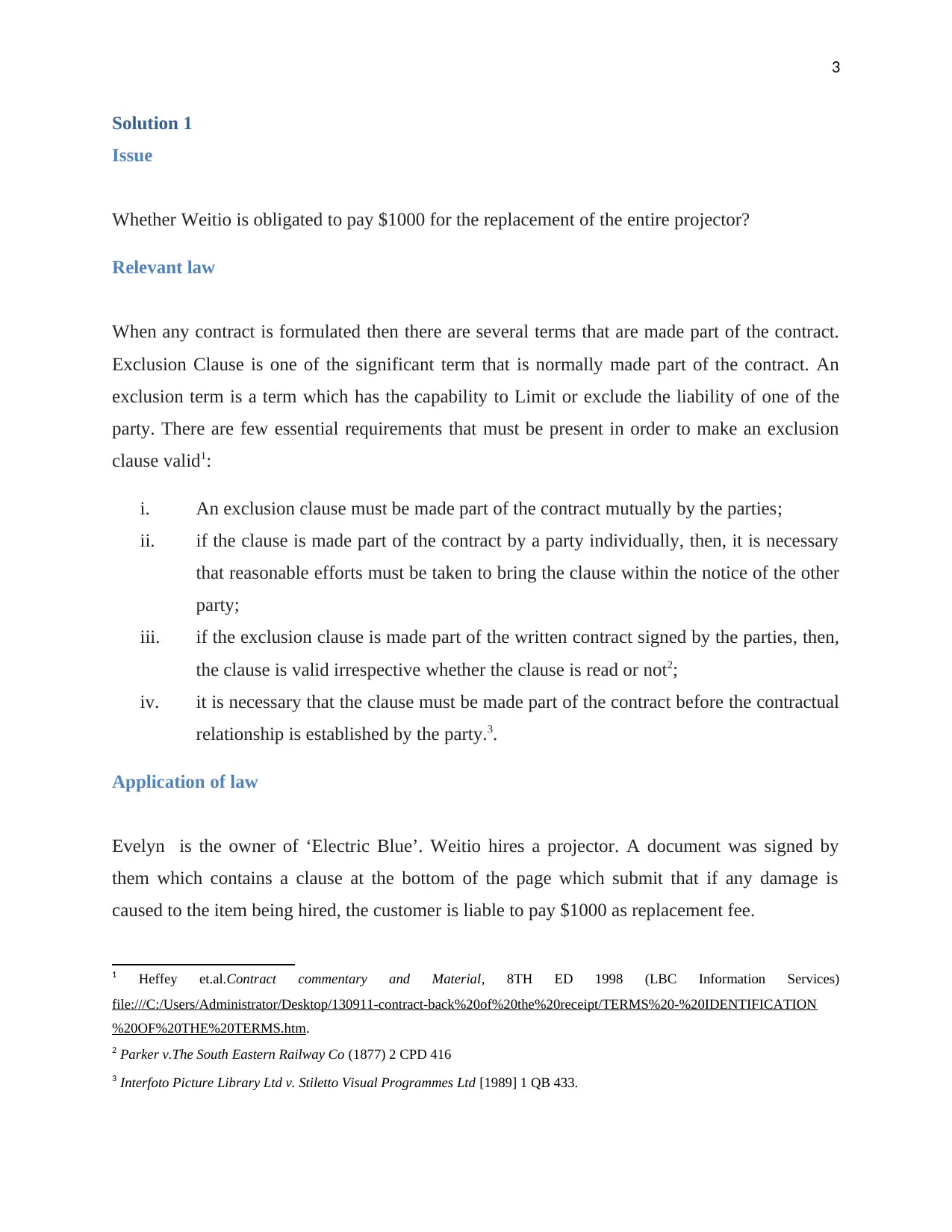
3
Solution 1
Issue
Whether Weitio is obligated to pay $1000 for the replacement of the entire projector?
Relevant law
When any contract is formulated then there are several terms that are made part of the contract.
Exclusion Clause is one of the significant term that is normally made part of the contract. An
exclusion term is a term which has the capability to Limit or exclude the liability of one of the
party. There are few essential requirements that must be present in order to make an exclusion
clause valid1:
i. An exclusion clause must be made part of the contract mutually by the parties;
ii. if the clause is made part of the contract by a party individually, then, it is necessary
that reasonable efforts must be taken to bring the clause within the notice of the other
party;
iii. if the exclusion clause is made part of the written contract signed by the parties, then,
the clause is valid irrespective whether the clause is read or not2;
iv. it is necessary that the clause must be made part of the contract before the contractual
relationship is established by the party.3.
Application of law
Evelyn is the owner of ‘Electric Blue’. Weitio hires a projector. A document was signed by
them which contains a clause at the bottom of the page which submit that if any damage is
caused to the item being hired, the customer is liable to pay $1000 as replacement fee.
1 Heffey et.al.Contract commentary and Material, 8TH ED 1998 (LBC Information Services)
file:///C:/Users/Administrator/Desktop/130911-contract-back%20of%20the%20receipt/TERMS%20-%20IDENTIFICATION
%20OF%20THE%20TERMS.htm.
2 Parker v.The South Eastern Railway Co (1877) 2 CPD 416
3 Interfoto Picture Library Ltd v. Stiletto Visual Programmes Ltd [1989] 1 QB 433.
Solution 1
Issue
Whether Weitio is obligated to pay $1000 for the replacement of the entire projector?
Relevant law
When any contract is formulated then there are several terms that are made part of the contract.
Exclusion Clause is one of the significant term that is normally made part of the contract. An
exclusion term is a term which has the capability to Limit or exclude the liability of one of the
party. There are few essential requirements that must be present in order to make an exclusion
clause valid1:
i. An exclusion clause must be made part of the contract mutually by the parties;
ii. if the clause is made part of the contract by a party individually, then, it is necessary
that reasonable efforts must be taken to bring the clause within the notice of the other
party;
iii. if the exclusion clause is made part of the written contract signed by the parties, then,
the clause is valid irrespective whether the clause is read or not2;
iv. it is necessary that the clause must be made part of the contract before the contractual
relationship is established by the party.3.
Application of law
Evelyn is the owner of ‘Electric Blue’. Weitio hires a projector. A document was signed by
them which contains a clause at the bottom of the page which submit that if any damage is
caused to the item being hired, the customer is liable to pay $1000 as replacement fee.
1 Heffey et.al.Contract commentary and Material, 8TH ED 1998 (LBC Information Services)
file:///C:/Users/Administrator/Desktop/130911-contract-back%20of%20the%20receipt/TERMS%20-%20IDENTIFICATION
%20OF%20THE%20TERMS.htm.
2 Parker v.The South Eastern Railway Co (1877) 2 CPD 416
3 Interfoto Picture Library Ltd v. Stiletto Visual Programmes Ltd [1989] 1 QB 433.
⊘ This is a preview!⊘
Do you want full access?
Subscribe today to unlock all pages.

Trusted by 1+ million students worldwide
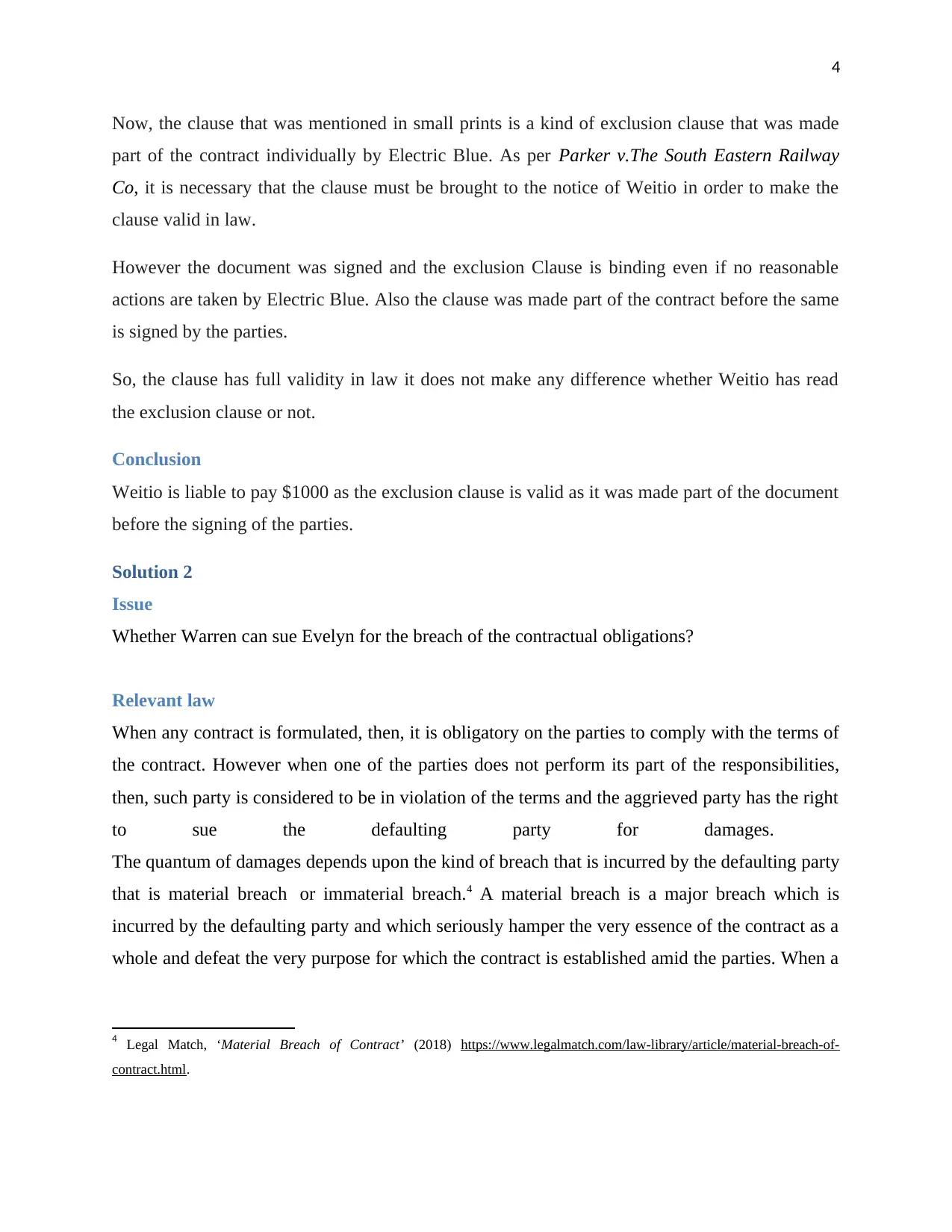
4
Now, the clause that was mentioned in small prints is a kind of exclusion clause that was made
part of the contract individually by Electric Blue. As per Parker v.The South Eastern Railway
Co, it is necessary that the clause must be brought to the notice of Weitio in order to make the
clause valid in law.
However the document was signed and the exclusion Clause is binding even if no reasonable
actions are taken by Electric Blue. Also the clause was made part of the contract before the same
is signed by the parties.
So, the clause has full validity in law it does not make any difference whether Weitio has read
the exclusion clause or not.
Conclusion
Weitio is liable to pay $1000 as the exclusion clause is valid as it was made part of the document
before the signing of the parties.
Solution 2
Issue
Whether Warren can sue Evelyn for the breach of the contractual obligations?
Relevant law
When any contract is formulated, then, it is obligatory on the parties to comply with the terms of
the contract. However when one of the parties does not perform its part of the responsibilities,
then, such party is considered to be in violation of the terms and the aggrieved party has the right
to sue the defaulting party for damages.
The quantum of damages depends upon the kind of breach that is incurred by the defaulting party
that is material breach or immaterial breach.4 A material breach is a major breach which is
incurred by the defaulting party and which seriously hamper the very essence of the contract as a
whole and defeat the very purpose for which the contract is established amid the parties. When a
4 Legal Match, ‘Material Breach of Contract’ (2018) https://www.legalmatch.com/law-library/article/material-breach-of-
contract.html.
Now, the clause that was mentioned in small prints is a kind of exclusion clause that was made
part of the contract individually by Electric Blue. As per Parker v.The South Eastern Railway
Co, it is necessary that the clause must be brought to the notice of Weitio in order to make the
clause valid in law.
However the document was signed and the exclusion Clause is binding even if no reasonable
actions are taken by Electric Blue. Also the clause was made part of the contract before the same
is signed by the parties.
So, the clause has full validity in law it does not make any difference whether Weitio has read
the exclusion clause or not.
Conclusion
Weitio is liable to pay $1000 as the exclusion clause is valid as it was made part of the document
before the signing of the parties.
Solution 2
Issue
Whether Warren can sue Evelyn for the breach of the contractual obligations?
Relevant law
When any contract is formulated, then, it is obligatory on the parties to comply with the terms of
the contract. However when one of the parties does not perform its part of the responsibilities,
then, such party is considered to be in violation of the terms and the aggrieved party has the right
to sue the defaulting party for damages.
The quantum of damages depends upon the kind of breach that is incurred by the defaulting party
that is material breach or immaterial breach.4 A material breach is a major breach which is
incurred by the defaulting party and which seriously hamper the very essence of the contract as a
whole and defeat the very purpose for which the contract is established amid the parties. When a
4 Legal Match, ‘Material Breach of Contract’ (2018) https://www.legalmatch.com/law-library/article/material-breach-of-
contract.html.
Paraphrase This Document
Need a fresh take? Get an instant paraphrase of this document with our AI Paraphraser
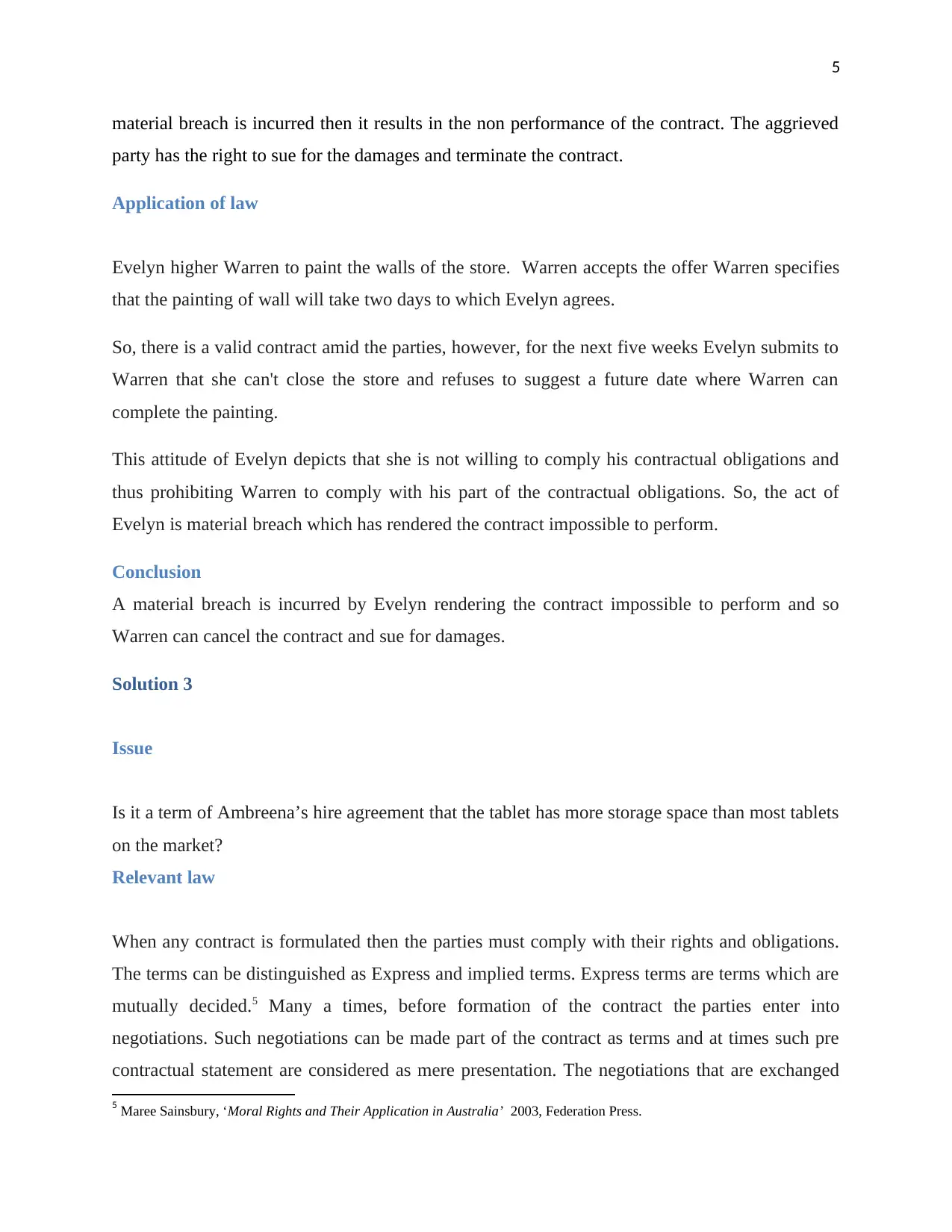
5
material breach is incurred then it results in the non performance of the contract. The aggrieved
party has the right to sue for the damages and terminate the contract.
Application of law
Evelyn higher Warren to paint the walls of the store. Warren accepts the offer Warren specifies
that the painting of wall will take two days to which Evelyn agrees.
So, there is a valid contract amid the parties, however, for the next five weeks Evelyn submits to
Warren that she can't close the store and refuses to suggest a future date where Warren can
complete the painting.
This attitude of Evelyn depicts that she is not willing to comply his contractual obligations and
thus prohibiting Warren to comply with his part of the contractual obligations. So, the act of
Evelyn is material breach which has rendered the contract impossible to perform.
Conclusion
A material breach is incurred by Evelyn rendering the contract impossible to perform and so
Warren can cancel the contract and sue for damages.
Solution 3
Issue
Is it a term of Ambreena’s hire agreement that the tablet has more storage space than most tablets
on the market?
Relevant law
When any contract is formulated then the parties must comply with their rights and obligations.
The terms can be distinguished as Express and implied terms. Express terms are terms which are
mutually decided.5 Many a times, before formation of the contract the parties enter into
negotiations. Such negotiations can be made part of the contract as terms and at times such pre
contractual statement are considered as mere presentation. The negotiations that are exchanged
5 Maree Sainsbury, ‘Moral Rights and Their Application in Australia’ 2003, Federation Press.
material breach is incurred then it results in the non performance of the contract. The aggrieved
party has the right to sue for the damages and terminate the contract.
Application of law
Evelyn higher Warren to paint the walls of the store. Warren accepts the offer Warren specifies
that the painting of wall will take two days to which Evelyn agrees.
So, there is a valid contract amid the parties, however, for the next five weeks Evelyn submits to
Warren that she can't close the store and refuses to suggest a future date where Warren can
complete the painting.
This attitude of Evelyn depicts that she is not willing to comply his contractual obligations and
thus prohibiting Warren to comply with his part of the contractual obligations. So, the act of
Evelyn is material breach which has rendered the contract impossible to perform.
Conclusion
A material breach is incurred by Evelyn rendering the contract impossible to perform and so
Warren can cancel the contract and sue for damages.
Solution 3
Issue
Is it a term of Ambreena’s hire agreement that the tablet has more storage space than most tablets
on the market?
Relevant law
When any contract is formulated then the parties must comply with their rights and obligations.
The terms can be distinguished as Express and implied terms. Express terms are terms which are
mutually decided.5 Many a times, before formation of the contract the parties enter into
negotiations. Such negotiations can be made part of the contract as terms and at times such pre
contractual statement are considered as mere presentation. The negotiations that are exchanged
5 Maree Sainsbury, ‘Moral Rights and Their Application in Australia’ 2003, Federation Press.
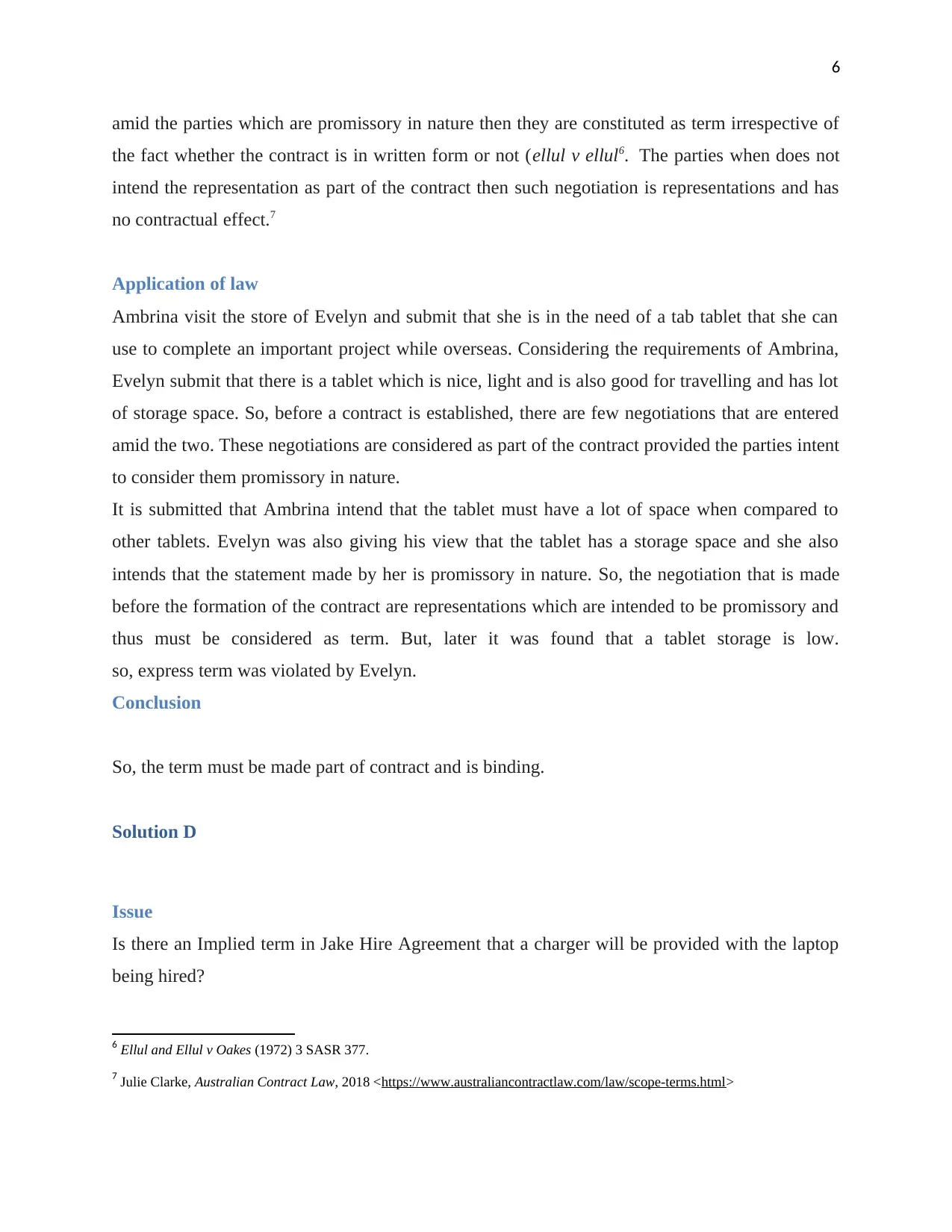
6
amid the parties which are promissory in nature then they are constituted as term irrespective of
the fact whether the contract is in written form or not (ellul v ellul6. The parties when does not
intend the representation as part of the contract then such negotiation is representations and has
no contractual effect.7
Application of law
Ambrina visit the store of Evelyn and submit that she is in the need of a tab tablet that she can
use to complete an important project while overseas. Considering the requirements of Ambrina,
Evelyn submit that there is a tablet which is nice, light and is also good for travelling and has lot
of storage space. So, before a contract is established, there are few negotiations that are entered
amid the two. These negotiations are considered as part of the contract provided the parties intent
to consider them promissory in nature.
It is submitted that Ambrina intend that the tablet must have a lot of space when compared to
other tablets. Evelyn was also giving his view that the tablet has a storage space and she also
intends that the statement made by her is promissory in nature. So, the negotiation that is made
before the formation of the contract are representations which are intended to be promissory and
thus must be considered as term. But, later it was found that a tablet storage is low.
so, express term was violated by Evelyn.
Conclusion
So, the term must be made part of contract and is binding.
Solution D
Issue
Is there an Implied term in Jake Hire Agreement that a charger will be provided with the laptop
being hired?
6 Ellul and Ellul v Oakes (1972) 3 SASR 377.
7 Julie Clarke, Australian Contract Law, 2018 <https://www.australiancontractlaw.com/law/scope-terms.html>
amid the parties which are promissory in nature then they are constituted as term irrespective of
the fact whether the contract is in written form or not (ellul v ellul6. The parties when does not
intend the representation as part of the contract then such negotiation is representations and has
no contractual effect.7
Application of law
Ambrina visit the store of Evelyn and submit that she is in the need of a tab tablet that she can
use to complete an important project while overseas. Considering the requirements of Ambrina,
Evelyn submit that there is a tablet which is nice, light and is also good for travelling and has lot
of storage space. So, before a contract is established, there are few negotiations that are entered
amid the two. These negotiations are considered as part of the contract provided the parties intent
to consider them promissory in nature.
It is submitted that Ambrina intend that the tablet must have a lot of space when compared to
other tablets. Evelyn was also giving his view that the tablet has a storage space and she also
intends that the statement made by her is promissory in nature. So, the negotiation that is made
before the formation of the contract are representations which are intended to be promissory and
thus must be considered as term. But, later it was found that a tablet storage is low.
so, express term was violated by Evelyn.
Conclusion
So, the term must be made part of contract and is binding.
Solution D
Issue
Is there an Implied term in Jake Hire Agreement that a charger will be provided with the laptop
being hired?
6 Ellul and Ellul v Oakes (1972) 3 SASR 377.
7 Julie Clarke, Australian Contract Law, 2018 <https://www.australiancontractlaw.com/law/scope-terms.html>
⊘ This is a preview!⊘
Do you want full access?
Subscribe today to unlock all pages.

Trusted by 1+ million students worldwide
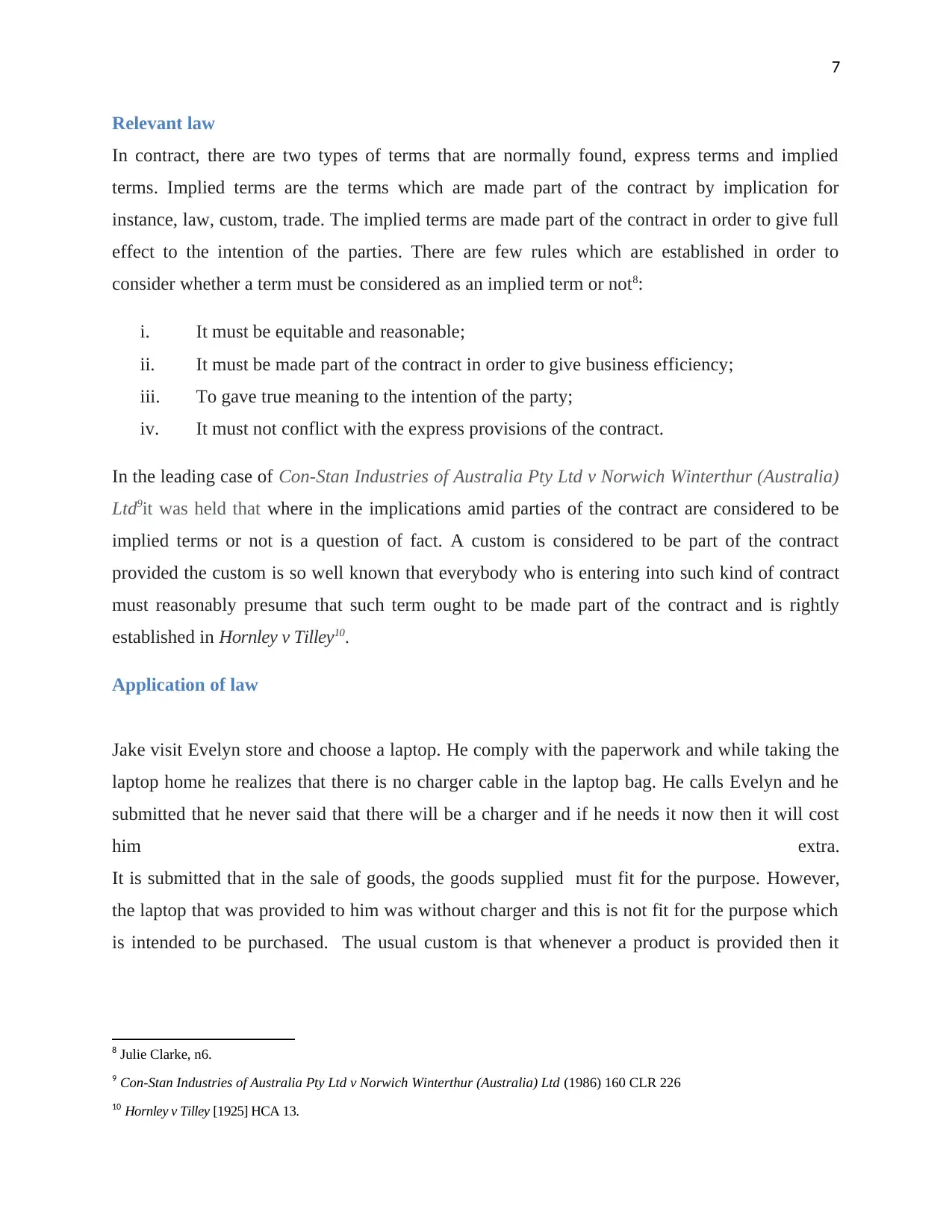
7
Relevant law
In contract, there are two types of terms that are normally found, express terms and implied
terms. Implied terms are the terms which are made part of the contract by implication for
instance, law, custom, trade. The implied terms are made part of the contract in order to give full
effect to the intention of the parties. There are few rules which are established in order to
consider whether a term must be considered as an implied term or not8:
i. It must be equitable and reasonable;
ii. It must be made part of the contract in order to give business efficiency;
iii. To gave true meaning to the intention of the party;
iv. It must not conflict with the express provisions of the contract.
In the leading case of Con-Stan Industries of Australia Pty Ltd v Norwich Winterthur (Australia)
Ltd9it was held that where in the implications amid parties of the contract are considered to be
implied terms or not is a question of fact. A custom is considered to be part of the contract
provided the custom is so well known that everybody who is entering into such kind of contract
must reasonably presume that such term ought to be made part of the contract and is rightly
established in Hornley v Tilley10.
Application of law
Jake visit Evelyn store and choose a laptop. He comply with the paperwork and while taking the
laptop home he realizes that there is no charger cable in the laptop bag. He calls Evelyn and he
submitted that he never said that there will be a charger and if he needs it now then it will cost
him extra.
It is submitted that in the sale of goods, the goods supplied must fit for the purpose. However,
the laptop that was provided to him was without charger and this is not fit for the purpose which
is intended to be purchased. The usual custom is that whenever a product is provided then it
8 Julie Clarke, n6.
9 Con-Stan Industries of Australia Pty Ltd v Norwich Winterthur (Australia) Ltd (1986) 160 CLR 226
10 Hornley v Tilley [1925] HCA 13.
Relevant law
In contract, there are two types of terms that are normally found, express terms and implied
terms. Implied terms are the terms which are made part of the contract by implication for
instance, law, custom, trade. The implied terms are made part of the contract in order to give full
effect to the intention of the parties. There are few rules which are established in order to
consider whether a term must be considered as an implied term or not8:
i. It must be equitable and reasonable;
ii. It must be made part of the contract in order to give business efficiency;
iii. To gave true meaning to the intention of the party;
iv. It must not conflict with the express provisions of the contract.
In the leading case of Con-Stan Industries of Australia Pty Ltd v Norwich Winterthur (Australia)
Ltd9it was held that where in the implications amid parties of the contract are considered to be
implied terms or not is a question of fact. A custom is considered to be part of the contract
provided the custom is so well known that everybody who is entering into such kind of contract
must reasonably presume that such term ought to be made part of the contract and is rightly
established in Hornley v Tilley10.
Application of law
Jake visit Evelyn store and choose a laptop. He comply with the paperwork and while taking the
laptop home he realizes that there is no charger cable in the laptop bag. He calls Evelyn and he
submitted that he never said that there will be a charger and if he needs it now then it will cost
him extra.
It is submitted that in the sale of goods, the goods supplied must fit for the purpose. However,
the laptop that was provided to him was without charger and this is not fit for the purpose which
is intended to be purchased. The usual custom is that whenever a product is provided then it
8 Julie Clarke, n6.
9 Con-Stan Industries of Australia Pty Ltd v Norwich Winterthur (Australia) Ltd (1986) 160 CLR 226
10 Hornley v Tilley [1925] HCA 13.
Paraphrase This Document
Need a fresh take? Get an instant paraphrase of this document with our AI Paraphraser
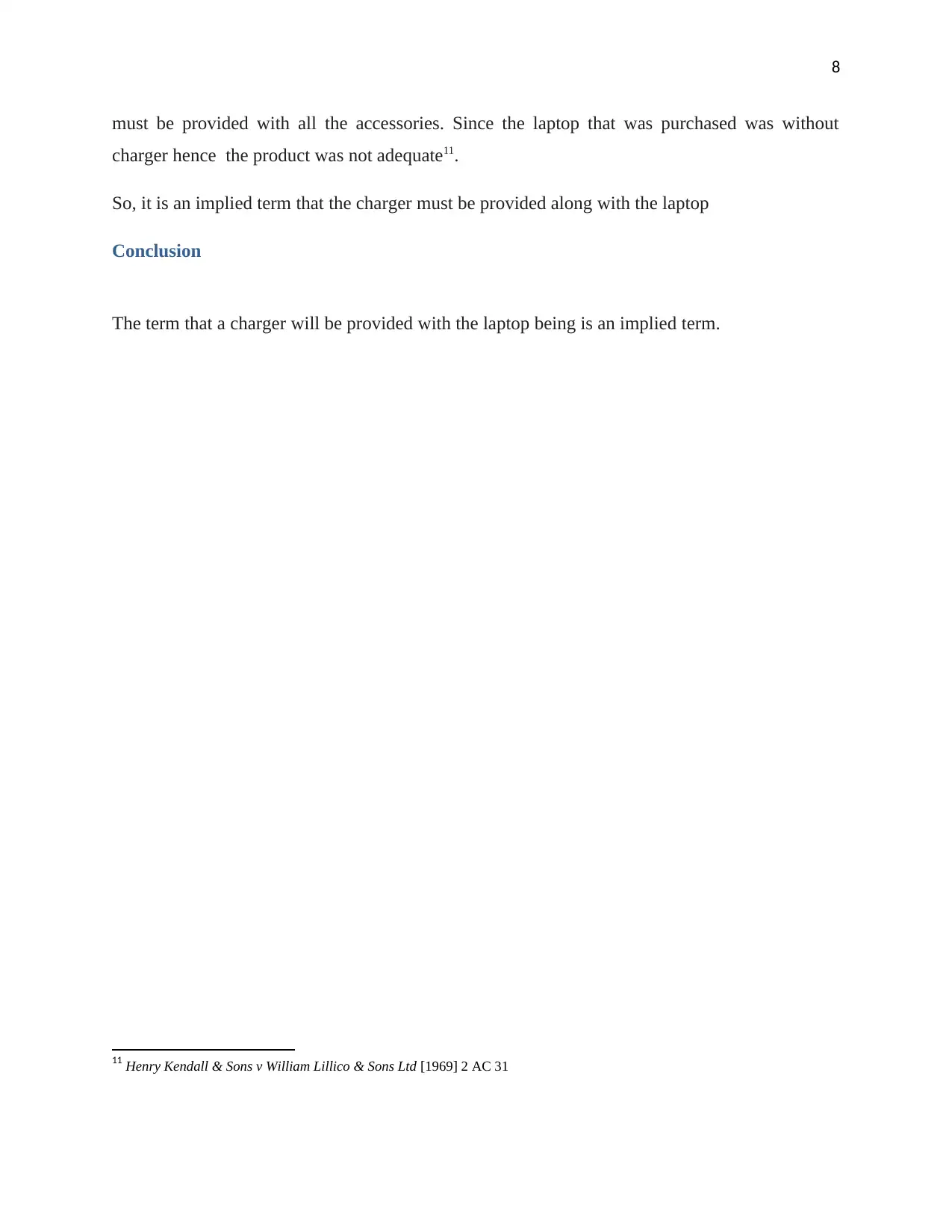
8
must be provided with all the accessories. Since the laptop that was purchased was without
charger hence the product was not adequate11.
So, it is an implied term that the charger must be provided along with the laptop
Conclusion
The term that a charger will be provided with the laptop being is an implied term.
11 Henry Kendall & Sons v William Lillico & Sons Ltd [1969] 2 AC 31
must be provided with all the accessories. Since the laptop that was purchased was without
charger hence the product was not adequate11.
So, it is an implied term that the charger must be provided along with the laptop
Conclusion
The term that a charger will be provided with the laptop being is an implied term.
11 Henry Kendall & Sons v William Lillico & Sons Ltd [1969] 2 AC 31
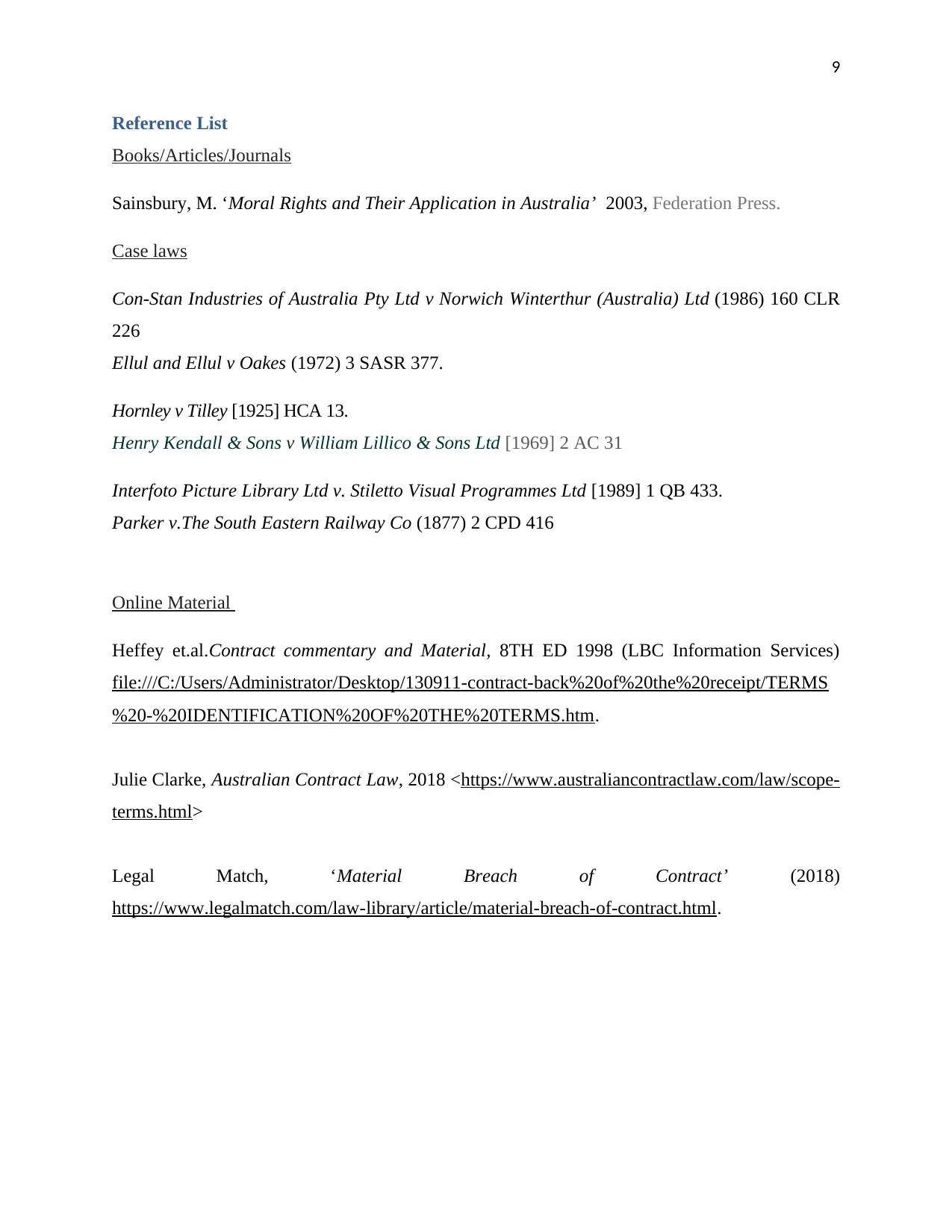
9
Reference List
Books/Articles/Journals
Sainsbury, M. ‘Moral Rights and Their Application in Australia’ 2003, Federation Press.
Case laws
Con-Stan Industries of Australia Pty Ltd v Norwich Winterthur (Australia) Ltd (1986) 160 CLR
226
Ellul and Ellul v Oakes (1972) 3 SASR 377.
Hornley v Tilley [1925] HCA 13.
Henry Kendall & Sons v William Lillico & Sons Ltd [1969] 2 AC 31
Interfoto Picture Library Ltd v. Stiletto Visual Programmes Ltd [1989] 1 QB 433.
Parker v.The South Eastern Railway Co (1877) 2 CPD 416
Online Material
Heffey et.al.Contract commentary and Material, 8TH ED 1998 (LBC Information Services)
file:///C:/Users/Administrator/Desktop/130911-contract-back%20of%20the%20receipt/TERMS
%20-%20IDENTIFICATION%20OF%20THE%20TERMS.htm.
Julie Clarke, Australian Contract Law, 2018 <https://www.australiancontractlaw.com/law/scope-
terms.html>
Legal Match, ‘Material Breach of Contract’ (2018)
https://www.legalmatch.com/law-library/article/material-breach-of-contract.html.
Reference List
Books/Articles/Journals
Sainsbury, M. ‘Moral Rights and Their Application in Australia’ 2003, Federation Press.
Case laws
Con-Stan Industries of Australia Pty Ltd v Norwich Winterthur (Australia) Ltd (1986) 160 CLR
226
Ellul and Ellul v Oakes (1972) 3 SASR 377.
Hornley v Tilley [1925] HCA 13.
Henry Kendall & Sons v William Lillico & Sons Ltd [1969] 2 AC 31
Interfoto Picture Library Ltd v. Stiletto Visual Programmes Ltd [1989] 1 QB 433.
Parker v.The South Eastern Railway Co (1877) 2 CPD 416
Online Material
Heffey et.al.Contract commentary and Material, 8TH ED 1998 (LBC Information Services)
file:///C:/Users/Administrator/Desktop/130911-contract-back%20of%20the%20receipt/TERMS
%20-%20IDENTIFICATION%20OF%20THE%20TERMS.htm.
Julie Clarke, Australian Contract Law, 2018 <https://www.australiancontractlaw.com/law/scope-
terms.html>
Legal Match, ‘Material Breach of Contract’ (2018)
https://www.legalmatch.com/law-library/article/material-breach-of-contract.html.
⊘ This is a preview!⊘
Do you want full access?
Subscribe today to unlock all pages.

Trusted by 1+ million students worldwide
1 out of 9
Related Documents
Your All-in-One AI-Powered Toolkit for Academic Success.
+13062052269
info@desklib.com
Available 24*7 on WhatsApp / Email
![[object Object]](/_next/static/media/star-bottom.7253800d.svg)
Unlock your academic potential
Copyright © 2020–2025 A2Z Services. All Rights Reserved. Developed and managed by ZUCOL.




